
National Park Service rustic – sometimes colloquially called Parkitecture – is a style of architecture that developed in the early and middle 20th century in the United States National Park Service (NPS) through its efforts to create buildings that harmonized with the natural environment. Since its founding in 1916, the NPS sought to design and build visitor facilities without visually interrupting the natural or historic surroundings. The early results were characterized by intensive use of hand labor and a rejection of the regularity and symmetry of the industrial world, reflecting connections with the Arts and Crafts movement and American Picturesque architecture.
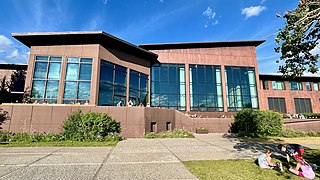
Jackson Lake Lodge is located near Moran in Grand Teton National Park, in the U.S. state of Wyoming. The lodge has 385 rooms, a restaurant, conference rooms, and offers numerous recreational opportunities. The lodge is owned by the National Park Service, and operated under contract by the Grand Teton Lodge Company. The Grand Teton Lodge Company also manages the Jenny Lake Lodge, as well as cabins, restaurants and other services at Colter Bay Village. The lodge is located east of Jackson Lake adjacent to prime moose habitat below the Jackson Lake Dam.

Grand Canyon Village Historic District comprises the historic center of Grand Canyon Village, on the South Rim of the Grand Canyon in Grand Canyon National Park, Arizona. The district includes numerous landmark park structures, many of which are National Historic Landmarks themselves, or are listed on the National Register of Historic Places. The town design as a whole is also significant for its attention to integration with the Grand Canyon landscape, its incorporation of National Park Service Rustic design elements, and for the idiosyncratic design of park concessioner structures such as the El Tovar Hotel.
Moran is an unincorporated village in south central Teton County, Wyoming, United States: as the community has had two different names, the Board on Geographic Names officially ruled in favor of "Moran" in 1970. It lies in Grand Teton National Park, 29 miles northeast of the city of Jackson, the county seat of Teton County, just northwest by side road of the intersection of U.S. Routes 26, 89, 191 and 287. Its elevation is 6,749 feet (2,057 m) and includes one of the principal entrance-fee collection stations for the Park. Moran also has the post office serving ZIP code of 83013, and a public elementary school; and no other services or businesses.

The Highlands Historic District in Grand Teton National Park is a former private inholding within the park boundary. The inholding began as a 1914 homestead belonging to Harry and Elizabeth Sensenbach, who began in the 1920s to supplement their income by catering to automobile-borne tourists. In 1946 the property was purchased by Charles Byron, Jeanne Jenkins and Gloria Jenkins Wardell, who expanded the accommodations by one or two cabins a year in a U-shaped layout around a central lodge. The lodge and cabins are constructed in a rustic log style, considered compatible with park architecture. The Highlands was neither an auto camp, which encouraged short stays, nor a dude ranch, which provided ranch-style activities. The Highlands encouraged stays of moderate length, providing a variety of relatively sedentary amenities. It was the last private-accommodation camp to be built in the park before the Mission 66 program created concessioner-operated facilities on public lands.

The AMK Ranch is a former personal retreat on the eastern shore of Jackson Lake in Grand Teton National Park. Also known as the Merymare, Lonetree and Mae-Lou Ranch, it was a former homestead, expanded beginning in the 1920s by William Louis Johnson, then further developed in the 1930s by Alfred Berol (Berolzheimer). Johnson built a lodge, barn and boathouse in 1927, while Berol added a larger lodge, new boathouse, and cabins, all in the rustic style.
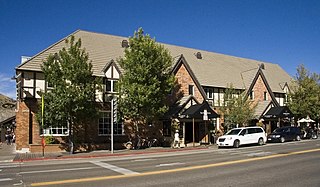
The Wort Hotel was built in downtown Jackson, Wyoming, United States by brothers John and Jess Wort, who were significant figures in the transformation of the economy of Jackson Hole from ranching to tourism. The somewhat Tudor-style building was the first luxury hotel in Jackson. The two-story building features brick facing, with half-timbering and stucco on the second floor and a series of gables facing the street.
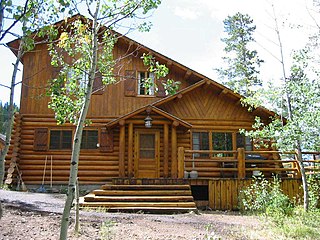
The Brinkerhoff is a historic lodge in Grand Teton National Park on the shore of Jackson Lake. It is the last remaining example of a forest lease vacation lodge in the park. The log house and caretaker's lodge were designed by architect Jan Wilking of Casper, Wyoming and were built in 1946 in what was then U.S. Forest Service land for the Brinkerhoff family. After the creation of Grand Teton National Park, the National Park Service acquired the property and used it for VIP housing. Among the guests at the Brinkerhoff were John F. Kennedy and Richard M. Nixon. The lodge is also notable as a post-war adaptation of the rustic style of architecture. The interior is an intact example of this transitional style.
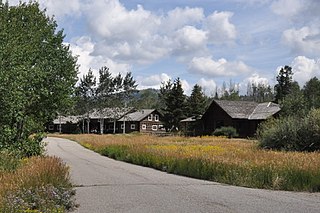
The Ramshorn Dude Ranch Lodge in Grand Teton National Park was built after 1935 by mountaineers Paul Petzoldt, founder of the National Outdoor Leadership School, and Gustav Koven. The property that became the Ramshorn Ranch was originally established by Ransom Adams at the mouth of Gros Ventre Canyon near Ditch Creek. By 1921 the property was acquired by Jack and Dollye Woodsman, who established the Flying V dude ranch, featuring a large central lodge. In 1932 the lodge burned, prompting the Woodsmans to sell the ranch to Koven and Petzoldt in 1935, who planned to expand the dude ranch as a climbing school and hunting camp. Petzoldt withdrew from the partnership in 1937 after suggesting the name be changed to the Ramshorn Ranch. The present lodge was completed in 1937 by the Woodward brothers, who took over operation. A variety of owners and partners ensued until 1956, when the ranch was sold to the National Park Service. The Park Service then leased the ranch back to concessioners who operated it as the Elbo Ranch until 1973, replacing the former Elbo Ranch purchased by the Park Service. The Teton Science School was established on the property in 1974 under a special use permit.

The Manges Cabin in Grand Teton National Park, also known as the Old Elbo Ranch Homestead Cabin, Mangus Cabin and the Taggart Creek Barn, was built in 1911 by James Manges. Manges was the second settler on the west side of the Snake River after Bill Menor, setting up a homestead near Taggart Creek. James Manges arrived in Jackson Hole in 1910, where he cut wood for Charles or William Wort. Manges' cabin is stated to have been the first two-story structure in the northern part of the valley. A root cellar was excavated beneath. The log and frame structure features wide eaves to keep the winter snow away from the walls. It was heated in winter by a single stove, with one room on each level.

Leek's Lodge is part of a former resort and dude ranch in Grand Teton National Park, near Jackson Lake. The ranch was established to offer activities to boys in a frontier setting. Its founder, Steven N. Leek, was instrumental in the establishment of the National Elk Refuge in Jackson Hole. The rustic lodge was built in 1927.

The White Grass Dude Ranch is located in the White Grass Valley of Grand Teton National Park. The rustic log lodge, dining hall service building and ten cabins were built when a working ranch was converted to a dude ranch, and represented one of the first dude ranch operations in Jackson Hole. The White Grass was established in 1913 by Harold Hammond and George Tucker Bispham, who combined two adjacent ranches or 160 acres (65 ha) each, and was converted to a dude ranch in 1919. Bispham had worked at the Bar B C before moving out on his own. The dude ranch operation continued to 1985, when the ranch was acquired by the National Park Service.

The Kimmel Kabins were a tourist camp in Grand Teton National Park. The camp was built in 1937 by J.D. and Lura Kimmel with a rustic lodge and eleven cabins on either side of Cottonwood Creek south of Jenny Lake. The camp is the only remaining example of a motor court-style camp in Grand Teton out of as many as twelve former establishments. The camp eventually featured a store with a post office.

The Jenny Lake Ranger Station Historic District comprises an area that was the main point of visitor contact in Grand Teton National Park from the 1930s to 1960. Located near Jenny Lake, the buildings are a mixture of purpose-built structures and existing buildings that were adapted for use by the National Park Service. The ranger station was built as a cabin by Lee Mangus north of Moose, Wyoming about 1925 and was moved and rebuilt around 1930 for Park Service use. A store was built by a concessioner, and comfort stations were built to Park Service standard plans. All buildings were planned to the prevailing National Park Service Rustic style, although the ranger station and the photo shop were built from parts of buildings located elsewhere in the park.
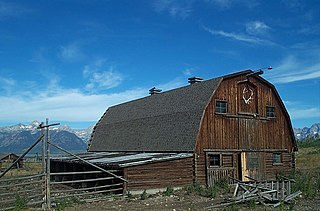
The Hunter Hereford Ranch was first homesteaded in 1909 by James Williams in the eastern portion of Jackson Hole, in what would become Grand Teton National Park. By the 1940s it was developed as a hobby ranch by William and Eileen Hunter and their foreman John Anderson. With its rustic log buildings it was used as the shooting location for the movie The Wild Country, while one structure with a stone fireplace was used in the 1963 movie Spencer's Mountain. The ranch is located on the extreme eastern edge of Jackson Hole under Shadow Mountain. It is unusual in having some areas of sagebrush-free pasture.

The Jenny Lake Boat Concession Facilities, also known as Reimer's Cabin and the Wort Boathouse, are a group of buildings on Jenny Lake in Grand Teton National Park. They include a dock, a boathouse, two employee cabins and Reimer's Cabin. The boathouse was built by concessioner Charles Wort, who held the original U.S. Forest Service use permit from the time before the establishment of Grand Teton National Park, when the lands and lake were under the jurisdiction of the Forest Service. Robert Reimer took over the concession by 1935 and built a personal residence in 1937. The log cabin is an example of the National Park Service Rustic style.

The Grand Lake Lodge hotel was opened in 1920 to serve tourists visiting Rocky Mountain National Park via the Trail Ridge Road, completed the same year. Located in Grand Lake, Colorado, the rustic lodge was founded by Frank Huntington and Roe Emery on land owned by the National Park Service at the edge of the park. The resort was affiliated with the Chicago, Burlington & Quincy Railroad.

The historical buildings and structures of Grand Teton National Park include a variety of buildings and built remains that pre-date the establishment of Grand Teton National Park, together with facilities built by the National Park Service to serve park visitors. Many of these places and structures have been placed on the National Register of Historic Places. The pre-Park Service structures include homestead cabins from the earliest settlement of Jackson Hole, working ranches that once covered the valley floor, and dude ranches or guest ranches that catered to the tourist trade that grew up in the 1920s and 1930s, before the park was expanded to encompass nearly all of Jackson Hole. Many of these were incorporated into the park to serve as Park Service personnel housing, or were razed to restore the landscape to a natural appearance. Others continued to function as inholdings under a life estate in which their former owners could continue to use and occupy the property until their death. Other buildings, built in the mountains after the initial establishment of the park in 1929, or in the valley after the park was expanded in 1950, were built by the Park Service to serve park visitors, frequently employing the National Park Service Rustic style of design.
Jenny Lake Lodge is a luxury resort concession in Grand Teton National Park. Located close to the base of the Teton Range at Jenny Lake, the resort as operated since the 1920s, when Tony Grace established the Danny Ranch, a dude ranch, on the site, with two rental cabins. The ranch was purchased by the Snake River Land Company, which made improvements starting around 1933, under the auspices of its operating company, the Teton Investment Company. The ranch's lodge burned in 1935, but a new lodge was built, accompanied by enough cabins to accommodate 65 guests.
The following articles relate to the history, geography, geology, flora, fauna, structures and recreation in Grand Teton National Park.


















